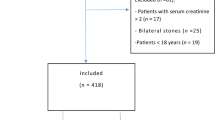Abstract
The purpose of this study is to determine the perioperative risk factors for increased blood loss in children undergoing percutaneous nephrolithotomy (PCNL).We retrospectively reviewed the data on pediatric patients who had undergone PCNL for stone disease in our department. Blood loss estimation was quantified by measuring the changes in hematocrit plus the volume of red blood cells transfused. Univariate and multivariate linear regression analyses were performed to evaluate risk factors associated with increased blood loss after pediatric PCNL. Variables included patient, stone, and treatment parameters. The study group consisted of 105 renal units in 97 children with a median (interquartile range) age of 5 (3–9) years. On univariate linear regression analysis female gender (p = 0.030), absence of hydronephrosis (p = 0.013), increasing stone burden (p = 0.002), staghorn stone type (p = 0.013), multi-tract access (p < 0.001), and prolonged operative time (p < 0.001) were significantly associated with increased blood loss after pediatric PCNL. However, multivariate linear regression analysis demonstrated that the only independent risk factors for increased blood loss following pediatric PCNL were degree of hydronephrosis (B −1.329, 95% CI −2.451 to −0.208, p = 0.021), number of tracts (B 2.545, 95% CI 0.221–4.869, p = 0.032), and operative time (B 0.031, 95% CI 0.008–0.053, p = 0.007). Identifying pediatric patients at increased risk of bleeding following PCNL is crucial to minimize morbidity and hospital stay, and thus, the cost of treatment. Our study demonstrated that degree of hydronephrosis, number of tracts and operative time are important factors in reducing blood loss during pediatric PCNL.
Similar content being viewed by others
References
Mahmud M, Zaidi Z (2004) Percutaneous nephrolithotomy in children before school age: experience of a Pakistani centre. BJU Int 94:1352–1354
Aron M, Yadav R, Goel R et al (2005) Percutaneous nephrolithotomy for complete staghorn calculi in preschool children. J Endourol 19:968–972
Manohar T, Ganpule AP, Shrivastav P, Desai M (2006) Percutaneous nephrolithotomy for complex caliceal calculi and staghorn stones in children less than 5 years of age. J Endourol 20:547–551
Dogan HS, Kilicarslan H, Kordan Y et al (2011) Percutaneous nephrolithotomy in children: does age matter? World J Urol 29:725–729
Woodside JR, Stevens GF, Stark GL et al (1985) Percutaneous stone removal in children. J Urol 134:1166–1167
Jackman SV, Hedican SP, Peters CA, Docimo SG (1998) Percutaneous nephrolithotomy in infants and preschool age children: experience with a new technique. Urology 52:697–701
Desai MR, Kukreja RA, Patel SH, Bapat SD (2004) Percutaneous nephrolithotomy for complex pediatric renal calculus disease. J Endourol 18:23–27
Shokeir AA, Sheir KZ, El-Nahas AR et al (2006) Treatment of renal stones in children: a comparison between percutaneous nephrolithotomy and shock wave lithotripsy. J Urol 176:706–710
Bilen CY, Kocak B, Kitirci G et al (2007) Percutaneous nephrolithotomy in children: lessons learned in 5 years at a single institution. J Urol 177:1867–1871
Onal B, Dogan HS, Satar N et al (2014) Factors affecting complication rates of percutaneous nephrolithotomy in children: results of a multi-institutional retrospective analysis by the Turkish pediatric urology society. J Urol 191:777–782
Citamak B, Altan M, Bozaci AC et al (2016) Percutaneous nephrolithotomy in children: 17 years of experience. J Urol 195:1082–1087
Kukreja R, Desai M, Patel S et al (2004) Factors affecting blood loss during percutaneous nephrolithotomy: prospective study. J Endourol 18:715–722
Turna B, Nazli O, Demiryoguran S et al (2007) Percutaneous nephrolithotomy: variables that influence hemorrhage. Urology 69:603–607
Akman T, Binbay M, Sari E et al (2011) Factors affecting bleeding during percutaneous nephrolithotomy: single surgeon experience. J Endourol 25:327–333
Lee JK, Kim BS, Park YK (2013) Predictive factors for bleeding during percutaneous nephrolithotomy. Korean J Urol 54:448–453
Zeren S, Satar N, Bayazit Y et al (2002) Percutaneous nephrolithotomy in the management of pediatric renal calculi. J Endourol 16:75–78
Ozden E, Sahin A, Tan B et al (2008) Percutaneous renal surgery in children with complex stones. J Pediatr Urol 4:295–298
Fernbach SK, Maizels M, Conway JJ (1993) Ultrasound grading of hydronephrosis: introduction to the system used by the Society for Fetal Urology. Pediatr Radiol 23:478–480
Marjorie J Arca (ed) (2013) Handbook of pediatric surgical critical care—APSA. https://www.eapsa.org/apsa/media/Documents/APSAHandbookofSurgicalCriticalCare_Jun52014.pdf
Marguet CG, Springhart WP, Tan YH et al (2005) Simultaneous combined use of flexible ureteroscopy and percutaneous nephrolithotomy to reduce the number of access tracts in the management of complex renal calculi. BJU Int 96:1097–1100
Ganpule AP, Mishra S, Desai MR (2009) Multiperc versus single perc with flexible instrumentation for staghorn calculi. J Endourol 23:1675–1678
Akman T, Binbay M, Ozgor F et al (2012) Comparison of percutaneous nephrolithotomy and retrograde flexible nephrolithotripsy for the management of 2–4 cm stones: a matched-pair analysis. BJU Int 109:1384–1389
Bryniarski P, Paradysz A, Zyczkowski M et al (2012) A randomized controlled study to analyze the safety and efficacy of percutaneous nephrolithotripsy and retrograde intrarenal surgery in the management of renal stones more than 2 cm in diameter. J Endourol 26:52–57
Takazawa R, Kitayama S, Tsujii T (2012) Successful outcome of flexible ureteroscopy with holmium laser lithotripsy for renal stones 2 cm or greater. Int J Urol 19:264–267
Author information
Authors and Affiliations
Contributions
Study conception and design: Senocak, Ozbek, Bozkurt, Unsal. Acquisition of data: Senocak, Ozbek. Analysis and/or interpretation of data: Senocak, Unsal. Drafting the article: Senocak, Ozbek, Bozkurt, Unsal. Revising it critically for important intellectual content: All authors. Final approval of the version to be published: All authors.
Corresponding author
Ethics declarations
Conflict of interest
The authors declare that they have no conflict of interest.
Ethical approval
All procedures performed in this study were in accordance with the ethical standards of our institutional review board with the 1964 Helsinki declaration. The institutional review board approved protocol number is 1219. The need for written informed consent was waived because this study was conducted by retrospective chart review.
Rights and permissions
About this article
Cite this article
Senocak, C., Ozbek, R., Bozkurt, O.F. et al. Predictive factors of bleeding among pediatric patients undergoing percutaneous nephrolithotomy. Urolithiasis 46, 383–389 (2018). https://doi.org/10.1007/s00240-017-1001-2
Received:
Accepted:
Published:
Issue Date:
DOI: https://doi.org/10.1007/s00240-017-1001-2




